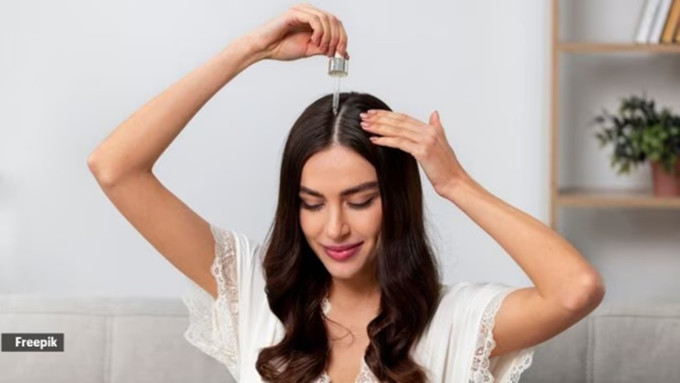The evolution of champis: How the Ayurvedic hair oiling practice found global fame
Over the last couple of months, hair oiling has been trending on social media. The traditional champi, or head massage, is suddenly in vogue, with content creators and brands showcasing their hair care routines using various oil blends. However, this age-old practice has a deep legacy. Champi has long been a ritual where mothers and grandmothers would lovingly slather oil on our hair to tame unruly locks while sharing wisdom, gossip, and celebrating womanhood.
Shalaka Kachare shared how her mother doesn’t oil her hair often, but when she has a headache, she asks her mother for a champi. “For me, champi is a way to show affection. No one can do that better than mothers!” Her mother Anjali recounted how she and her sisters used to sit on the terrace on Sundays, oiling each other’s hair and sharing gossip. “It was like a bonding activity,” she said.

Hair oiling is an integral part of India’s cultural fabric, with its first mention in Ayurveda, the traditional system of holistic healthcare and well-being. “Hair oiling, deeply rooted in traditional Ayurvedic medicine, has been a staple in many Indian households for centuries. The art of anointing one’s hair with nourishing oils has been revered for its ability to promote healthy hair growth, soothe the scalp, and enhance overall well-being,” said Smita Naram, co-founder of Ayushakti.
 In Ayurveda, hair oiling is considered to be a healing ritual than just a grooming routine. (Source: Freepik)
In Ayurveda, hair oiling is considered to be a healing ritual than just a grooming routine. (Source: Freepik)
Origins of hair oiling
“Maharishi Charak was the first to document Ayurveda in the 1st century CE, mentioning hair oiling in the ‘Charak Samhita,’ the oldest text of Ayurveda,” said Dr Kajal Dhingra, Ayurveda Expert at The Ayurveda Company. According to the text, hair oiling is part of the dinacharya, or daily regimen, recommended every morning or every two to three days.
“The benefits include strengthening all five senses, strengthening hair, controlling premature greying, and relieving headaches. This practice, dating back 5000 years, is a native Indian ritual,” Dhingra said.
In Ayurveda, hair oiling is considered a healing ritual rather than just a grooming routine.
Taila abhyanga (Oil massage) involves massaging warm herbal oils into the scalp and hair, believed to balance the body’s doshas (vital energies), particularly Pitta and Vata. The massage improves blood circulation, strengthens hair roots, and relieves stress.
Shirodhara: This therapeutic practice involves continuously pouring warm oil over the forehead and scalp. It calms the mind, reduces stress, and promotes hair health.
Weekly oiling: Hair oil should be applied regularly, typically once or twice a week. This routine helps deep condition the hair, prevent dandruff, and hydrate the scalp.
According to Naram, Ayurvedic experts recommend using oils that are suitable for an individual’s hair type, which is determined by their dosha.
For Vata (dry, brittle or frizzy) hair, warm oils like coconut oil, olive oil, or sesame oil are recommended. It will help nourish and moisturise dry hair.
Pitta (fine, thin or coloured) hair needs cool oils like amla oil, bhringaraj oil, or neem oil to help calm and soothe the scalp, reducing heat and promoting hair growth.
Kapha (oily, thick or curly) hair can work with light oils like rosemary oil, thyme oil, or tea tree oil to help balance the scalp’s natural oil production, reducing excess oiliness.
View this post on Instagram
A post shared by Priyanka (@priyankachopra)
So how did champis become cool?
Natasha Tuli, CEO and chief formulator at Soulflower, attributed platforms like TikTok and Instagram playing a pivotal role in popularising hair oiling.
“It is because of this age-old tradition of Ayurveda that Indians have long, lustrous hair, which westerners envy,” she said. “For example, rosemary oil has become the most talked-about product in hair care, with hundreds of influencers sharing their hair oiling routines using it,” Tuli said.
Tuli explained that the sudden hype is largely due to high-profile celebrities like Priyanka Chopra and Mindy Kaling discussing their hair oiling routines, making it a desirable beauty trend. This has prompted major brands to enter the market and offer products in mainstream stores, both online and offline. “With a presence in seven countries, including the US, UK, Japan, Australia, UAE, and Saudi Arabia, we’ve seen the global appeal of hair oiling,” she said.
Is hair oiling actually good for the scalp?
“The way I see it, hair oiling can be beneficial for scalp health and hair growth when done correctly. “Oils like coconut, argan, and jojoba provide essential moisture and nutrients, enhancing hair strength and reducing breakage. Massaging oil into the scalp improves blood circulation, promoting healthier follicles,” said Dr. Manisha P. Kothari,
Kosmoderma Skin, Hair & Body Clinics – Mumbai.
However, excessive oiling or using heavy oils can cause scalp build-up, clogged follicles, and greasy hair, particularly for those with naturally oily scalps.
Here’s how you should ideally apply hair oil
Kothari recommended using a comb to make proper partitions. “The ideal way to apply hair oil involves using a small amount of oil & gently massaging it into the scalp with your fingertips to stimulate blood flow, distributing evenly,” she said.
Focus on the roots and work down to the tips, leaving the oil on for a few hours for deeper penetration. Wash thoroughly with a mild shampoo to avoid build-up. Applying oil once or twice a week can maintain optimal scalp health and promote hair growth.
📣 For more lifestyle news, click here to join our WhatsApp Channel and also follow us on Instagram
Disclaimer: The copyright of this article belongs to the original author. Reposting this article is solely for the purpose of information dissemination and does not constitute any investment advice. If there is any infringement, please contact us immediately. We will make corrections or deletions as necessary. Thank you.
